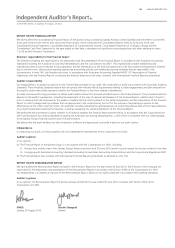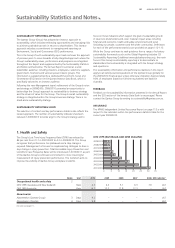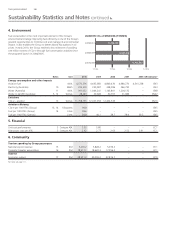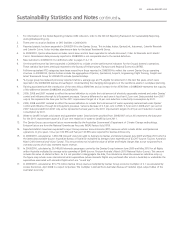Qantas 2010 Annual Report Download - page 116
Download and view the complete annual report
Please find page 116 of the 2010 Qantas annual report below. You can navigate through the pages in the report by either clicking on the pages listed below, or by using the keyword search tool below to find specific information within the annual report.
THE QANTAS GROUP 114
Compliance with Reporting Requirements
NATIONAL GREENHOUSE AND ENERGY REPORTING ACT 2007
(NGER ACT)
The National Greenhouse and Energy Reporting Act 2007 (NGER Act)
established a mandatory reporting system for Australian greenhouse
gas emissions and energy production and consumption. NGER data
will underpin the Australian Government’s proposed Carbon Pollution
Reduction Scheme although this scheme has been delayed until 2013.
The Qantas Group is obliged to report under the NGER Act. The rst
reporting year under the NGER Act was 1 July 2008 to 30 June 2009
and the Qantas Group reported total domestic emissions of 4,236,483
tonnes of carbon dioxide equivalent (CO2-e) (4,007,170 of scope 1 and
229,313 of scope 2) equivalent to 58,563,182 gigajoules of energy
consumed.
The emissions reported in the Group’s inaugural NGER report for
2008/2009 are not comparable to the emissions voluntarily reported
in the 2008/2009 Annual Report. Similarly, the emissions to be reported
in the Group’s NGER report for 2009/2010 will not be comparable to the
emissions reported in the 2009/2010 Annual Report.
The key differences between emissions and energy reported under the
NGER Act and emissions and energy voluntarily reported through the
Annual Report include:
—Scope of reportable emissions. The emissions reported in the Annual
Report relate to international and domestic emissions as de ned in
the Report. The NGER Act requires reporting of domestic Australian
emissions only and excludes emissions resulting from the consumption
of international bunker fuel. Emissions reported in both the
2008/2009 and 2009/2010 Qantas Group Annual Reports include
emissions from both domestic fuel and international bunker fuel.
This will have the greatest impact on the comparability of sustainability
reporting data and the data reported under the NGER Act
—The reporting boundary. The concept of operational control with
regard to determining reporting boundaries under the NGER Act
does not align with nancial and sustainability reporting boundaries.
Further, the NGER Act applies to activities from facilities that are under
Qantas’ operational control as opposed to only legal entities for
nancial and sustainability reporting purposes
—Reportable emissions sources. The emissions reported in the 2010
Qantas Group Annual Report include carbon dioxide equivalent
(CO2-e). Under NGER, reportable emissions sources include carbon
dioxide (CO2), carbon dioxide equivalent (CO2-e), hydro uorocarbons
(HFCs), nitrous oxide (N2O), methane (CH4) per uorocarbons (PFCs)
and sulphur hexa uoride (SF6)
EUROPEAN UNION EMISSIONS TRADING SCHEME – MONITORING,
REPORTING AND VERIFICATION (MRV)
Qantas is currently monitoring all Revenue Tonne Kilometre (RTK) and
Annual Emission (AE) data in accordance with the approved Monitoring,
Reporting and Veri cation (MRV) plans submitted to the United Kingdom
(UK) Responsible Authority (RA) in November 2009. The RTK and AE
data will undergo independent veri cation prior to being submitted to
the RA by March 2011. Submission of RTK data will make Qantas eligible
to receive up to a maximum of 85 per cent free emission allowances for
the commencement of the scheme in January 2012 (based on emissions
produced in 2010) and up to a maximum of 83 per cent free annual
emission allowances for the period 2013-2020 (based on emissions
in 2010).
ADDITIONAL COMPULSORY REPORTING REQUIREMENTS
The Qantas Group also ful ls its obligations in reporting to a diverse
number of additional compulsory reporting requirements, both state
based and international, for areas included in its sustainability landscape.
These include annual reporting requirements to a number of Australian
Government bodies such as the Equal Opportunity for Women
Agency (EOWA), Greenhouse FriendlyTM and the Energy Ef ciency
Opportunities (EEO).
Sustainability Statistics and Notes continued


















